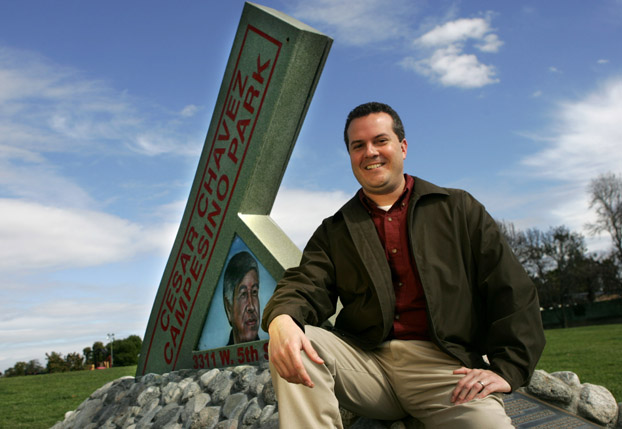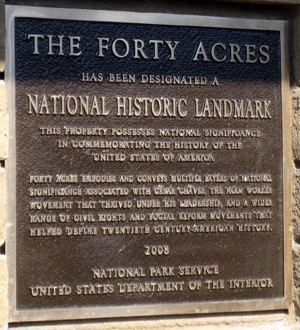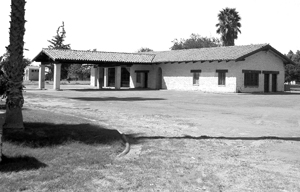 Caption: Raymond W. Rast, pictured at César Chávez Campesino Park in Santa Ana, is working on a study of sites affiliated with César E. Chávez and the farm labor movement to determine whether they should be designated as national historic landmarks. Photo by Karen TapiaDownload Photo
Caption: Raymond W. Rast, pictured at César Chávez Campesino Park in Santa Ana, is working on a study of sites affiliated with César E. Chávez and the farm labor movement to determine whether they should be designated as national historic landmarks. Photo by Karen TapiaDownload Photo
¡Sí, Se Puede!
Professor Researches National César Chávez Landmarks
Raymond W. Rast, assistant professor of history at Cal State Fullerton, is conducting research as part of a National Park Service project to name one or more landmarks in honor of César E. Chávez, the late labor leader who turned the phrase “¡Sí, Se Puede!” (Spanish for “yes, it can be done”) into the United Farm Workers’ rally cry.
Chávez’s “life is very inspiring,” Rast said. “He spent his childhood near Yuma, Ariz., but his parents lost their land during the Great Depression, and he experienced the pain of poverty as the family sought work up and down California. He also experienced the pain of discrimination, but he never lost his sense of dignity, and that’s really the key to understanding his life’s work. He recognized the dignity that all people share, regardless of their background, regardless of their occupation or economic status, regardless of where they were born or where they live.”
In 2007, Rast filed a nomination to have “The Forty Acres” — a 40-acre parcel of land in Delano acquired in 1966 under the nonprofit organization National Farm Workers Service Center that became the headquarters of the UFW — named a National Historic Landmark.
In Rast’s 56-page nomination, he wrote: “The Forty Acres holds multiple layers of extraordinary national significance for its close association with the productive career of César Chávez, the farm worker movement and a wider range of reform movements that helped define 20th-century American history, and in particular, the Chicano Movement.
“Chávez’s first public fast, one of many movement tactics, took place at the service station resulting in national media attention for the farm worker movement and bolstering his public image. Forty Acres represents not only the legacy of Chavez’s and the union’s work toward better working conditions for Mexican-American and Filipino agricultural workers, but an overall improvement in civil rights for Mexican-Americans and other minorities in the United States.”
 Caption: This plaque was dedicated at a ceremony on Feb. 21 at The Forty Acres in Delano. Photo by Raymond W. Rast
Caption: This plaque was dedicated at a ceremony on Feb. 21 at The Forty Acres in Delano. Photo by Raymond W. Rast
The National Historic Landmark designation was approved by Congress in 2008.
On Feb. 21 this year, Rast joined Ken Salazar, U.S. secretary of the interior, UFW President Arturo Rodriguez, members of Chávez’s family and others in Delano to christen the landmark with a plaque that reads: “This property possesses national significance in commemorating the history of the United States of America.”
In a related move three years ago, Congress passed legislation, introduced by then-Congresswoman Hilda Solis, now serving as U.S. secretary of labor, and Sen. John McCain (R-Ariz.) in 2008, authorizing a larger “Special Resource Study” of all sites related to Chávez in California and Arizona. Rast was selected to conduct the study.
“My work on The Forty Acres nomination helped me and the Center for Oral and Public History land the contract for the study,” said Rast, an associate director of the center. “This initiative has me, my students, National Park Service staff and stakeholders looking at various sites to determine if others might be eligible for listing on the National Register of Historic Places, designation as additional National Historic Landmarks, or potentially incorporating into the National Park System, such as a ‘César Chávez National Historic Site’ or something to that effect.”
Rast said his mother’s parents were Mexican, and their lives were shaped, in part, by migrant labor, low pay and discrimination.
“Chávez and his generation made it easier for my mother's generation to leave the fields behind or avoid them altogether,” Rast said. “I am fortunate to have lived a life even further removed from the kinds of things my grandparents faced, and Chávez deserves some of the credit for that. Of course, a legacy defined by recognizing human dignity, fighting discrimination, and opening doors for future generations is a legacy that anyone can admire. I hope my work helps make that clear.”
March 7, 2011
 This the service station on The Forty Acres site. Photo by Raymond W. Rast
This the service station on The Forty Acres site. Photo by Raymond W. Rast